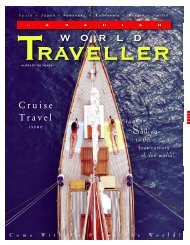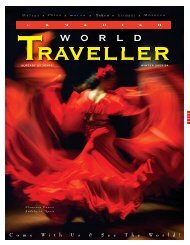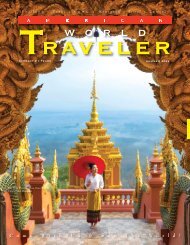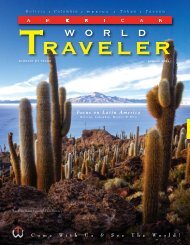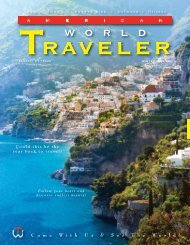Canadian World Traveller Winter 2021-22 Issue
Now in our 20th year of publishing, Canadian World Traveller explores the culture and history of worldwide destinations, sharing the adventure of discovery with our readers and motivating them to make their travel dreams a reality. Published quarterly, CWT helps sophisticated, independent Canadian travellers choose their next destination by offering a lively blend of intelligent, informative articles and tantalizing photographic images from our World’s best destinations, cruises, accommodations and activities to suit every traveller's taste.
Now in our 20th year of publishing, Canadian World Traveller explores the culture and history of worldwide destinations, sharing the adventure of discovery with our readers and motivating them to make their travel dreams a reality. Published quarterly, CWT helps sophisticated, independent Canadian travellers choose their next destination by offering a lively blend of intelligent, informative articles and tantalizing photographic images from our World’s best destinations, cruises, accommodations and activities to suit every traveller's taste.
You also want an ePaper? Increase the reach of your titles
YUMPU automatically turns print PDFs into web optimized ePapers that Google loves.
66<br />
<strong>Canadian</strong> <strong>World</strong> <strong>Traveller</strong> <strong>Winter</strong> <strong>2021</strong>-<strong>22</strong><br />
hundreds of plaques honouring deceased individuals.<br />
These memorials are paid for by relatives<br />
and close friends.<br />
We then headed down to the Po Lin<br />
Monastery, which lies in the shadow of the<br />
Buddha, to have a simple but satisfying vegetarian<br />
meal prepared by the monks.<br />
Village Theme Park<br />
The perfect return route from the Po Lin<br />
Monastery is to take a stroll through the nearby<br />
Ngong Ping Cultural Village, a sort of Chinese<br />
version of a North American theme park. After<br />
visiting its moving 'Walking with Buddha' pavilion<br />
we headed for the terminus of the Ngong Ping<br />
360.<br />
Sky-High Ride<br />
The Ngong Ping 360 is a spectacular 5.7km<br />
(3.5 miles), 25-minute ride that crosses Tung<br />
Chung Bay and touches on the Hong Kong airport<br />
island before heading towards North Lantau<br />
where we boarded one of its cars for our return<br />
trip from Po Lin Monastery.<br />
Date at Harbour City<br />
During our early supper at Harbour City,<br />
located in the Tsim Sha Tsui waterside district of<br />
Kowloon, excitement definitely was in the air as<br />
this was the night of the extraordinary annually<br />
held Lunar New Year Fireworks Display over<br />
Hong Kong's Victoria Harbour!<br />
Harbour City is an immense commercial<br />
complex that was built on the former site of<br />
wharfs and dockside warehouses.<br />
Fierce Temple God<br />
After the Wong Tai Sin Temple, where I had<br />
my fortune read, the Che Kung Temple is definitely<br />
Hong Kong's second most popular shrine.<br />
We visited this renowned Buddhist temple,<br />
located in the Sha Tin District of the New<br />
Territories, on the third day of Chinese New Year,<br />
which is the birthday of the shrine's demigod Che<br />
Kung.<br />
He was a fierce general from the Sung<br />
Dynasty (960-1279 AD) who was elevated to<br />
Buddhist immortality on account of his heroic<br />
deeds. His much-venerated towering bronze<br />
statue, which stands several metres tall in the<br />
main hall of the temple, is indeed an awesome<br />
sight to behold!<br />
Che Kung is considered by many to be Hong<br />
Kong's undisputed god of gambling and as such,<br />
thousands of worshipers gather here on his<br />
birthday to pray to him for good fortune in the<br />
coming year.<br />
Winds of Change<br />
Incense sticks and huge arrays of colourful<br />
paper windmills were for sale just outside the<br />
temple walls. Apparently, paper windmills purchased<br />
at the temple blow good luck winds into<br />
your home throughout the year when placed in a<br />
window or doorway.<br />
As the day wore on, it was amusing to see the<br />
discount signs for the windmills go up. But on a<br />
more serious note, I was once again totally<br />
astounded by the fervour of both young and old<br />
devotees of this impressive and obviously highly<br />
revered place of worship.<br />
Proud Heritage<br />
I wish I could say that my quest to find my<br />
Chinese roots ended in the historic heritage vil-<br />
lage of Ping Shan. It didn't, but this was as close<br />
as it got. My mum's maiden name was 'Cheong'<br />
but it could just as well been 'Tang' when I alighted<br />
in the village of Ping Shan.<br />
Ping Shan has one of the longest recorded<br />
histories in all of Hong Kong and the lineage of<br />
the Tang clan is firmly rooted right here.<br />
Considered one of the "Five Great Clans" in the<br />
New Territories, the Tang clan can amazingly<br />
trace its roots as far back as the twelfth century.<br />
High Threshold<br />
On entering his beautifully restored multi-storied<br />
ancestral village residence, an amusing<br />
anecdote was created by us having to step over<br />
the rather high threshold of the entranceway.<br />
Our guide Andy had previously told me that<br />
the reason for the high thresholds in village<br />
homes was to keep out the chickens and other<br />
village livestock! Now I learnt that the real reason<br />
was to remind visitors that they were entering<br />
a place that should be treated with reverence.<br />
Timeless Pagoda<br />
After touring the two levels of the fascinating<br />
Kun Ting Study Hall, which was built in 1870 by<br />
Tang Heung Chuen, a <strong>22</strong>nd-generation ancestor<br />
of the Tang clan, for students preparing for the<br />
imperial civil service examination, we strolled<br />
over to the site of Hong Kong's only truly ancient<br />
pagoda.<br />
The original five-storey Tsui Sing Lau Pagoda,<br />
which means "Pagoda of Gathering Stars", was<br />
built by Tang Yin-tung, a seventh generation<br />
ancestor of the clan, more than 600 years ago!<br />
It was damaged by strong winds and subsequently<br />
rebuilt as today's still impressive threestorey<br />
pagoda.<br />
Living Memories<br />
The really fascinating part of the Ping Shan<br />
Heritage Trail was visiting the recently established<br />
hilltop Tang Clan Gallery, which is housed<br />
in the Old Ping Shan Police Station built in 1899<br />
by the British.<br />
Happily, in 2007, the defunct colonial-styled<br />
police station was wonderfully restored and<br />
became the repository for many of the Tang<br />
Clan's treasured artefacts from its long line of<br />
notable ancestors. The gallery even includes a<br />
case displaying the historic outfit worn by our<br />
charming 'clan guide' Kwai Man on her own<br />
wedding day. How I wish I could have found<br />
such a remarkable tribute to the Cheong Clan!<br />
Kung Hei Fat Choy!<br />
For those not familiar with that greeting, it's<br />
Happy New Year in Chinese. And what a happy<br />
time it was to be in Hong Kong to celebrate the<br />
beginning of the Year of the Ox and to re-establish<br />
my Chinese connection!<br />
As I stood on one of the breathtaking lookout<br />
points on Victoria Peak, high above Hong Kong's<br />
forest of futuristic skyscrapers and its shimmering<br />
harbour on my last night in this scintillating city,<br />
I began the understand for the first time the contradictions<br />
inherent in my late Chinese grandfather<br />
Ol' Cheong. After all, he was Chinese yet<br />
Western - every bit like contrary yet totally loveable<br />
Hong Kong!<br />
www.discoverhongkong.com





